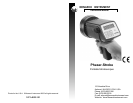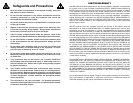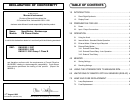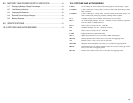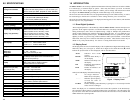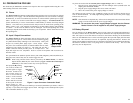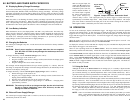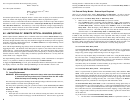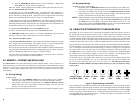
2
! !! !
! !! !
! !
Out In
!!
!!
!
""
""
"
Figure 2 Input/
Output Jacks
Signal Input
+6V Out to
Sensor
Common
(GND)
Common
(GND)
+6V Out to
Sensor
Signal Input
Figure 3 Input Connector Connection Detail
2.0 PREPARATION FOR USE
The Strobe may be hand held or mounted on a tripod or other user supplied bracket using the ¼-20
UNC bushing at the base of the handle.
2.1 Power
The Phaser-Strobe has internal rechargeable batteries and may also be powered by an optional
external AC power supply. The unit should be charged before use (see section 8.3 Charging
the Batteries), or can be run continuously from the AC mains with the optional power supply
(PSC-3 or PSC-4, see section 8.4 External Power Supply/Charger). The Phaser-Strobe can
operate continuously in excess of 60 minutes at 6000 flashes per minute from fully charged
batteries. The strobe has a protection feature that prevents the strobe from operating if the
battery voltage is low. This condition is indicated by no flash and the display starts blinking
“LO BAT”. At this time the batteries must be recharged. The actual operating time of the
stroboscope depends on the flash rate and duty cycle of operation. Slower flash rates increase
the operating time.
2.2 Input / Output Connections
The Phaser-Strobe has input and output jacks on the left side of the
stroboscope (see Figure 2). These can be used for external triggering
or synchronization (daisy chaining two or more strobes). These jacks
accept 1/8" (3.5mm) phone plugs (input – stereo, output – mono).
The jacks’ outer connection (barrel) is common and the inner or center
connection is the signal (see Figure 3). The input jack also has a
middle connection which provides power to an input sensor. The
input and output are TTL compatible. Refer to section 10.0 Options and Accessories for
interface cables.
The optional ROS-5P (Remote Optical Sensor), MT-190P (Magnetic), IRS-5P (Infrared), or
RLS-5P (Laser) sensors may also be used to trigger the unit.
NOTE: When using external sensors that are powered by the Phaser-Strobe, i.e. Remote
Optical Sensor (ROS-5P), the sensor must be plugged in before the stroboscope is
turned on, or the remote sensor may not be powered up.
The input jack (" pointing
into socket) enables an
external signal to trigger
the strobe. In order to use
the external signal you
have to ensure that the
strobe is in the External
mode. Press the EXT
button until the red LED
in the top left of the EXT
button comes on. The
range for triggering is from dc to 542 flashes per second (32,500 flashes per minute). There is
typically a 5 µsec delay from trigger input to flash. The trigger source should provide a pulse
with a minimum duration of 1 µsec.
11
To power the strobe with the external power supply/charger (PSC-3 or PSC-4):
1. Plug the power supply/charger cable into the recharger socket (located below the
display panel behind the handle).
2. Plug the power supply/charger into an AC mains wall outlet.
3. Move the switch on the power supply/charger to “RUN”.
The stroboscope may operate in the “CHARGE” setting, but will in fact be drawing power
from its internal batteries. An LED (light emitting diode) on the front of the power supply
indicates the unit is on.
NOTE: If the batteries are depleted, they will need to be charged for about 10 minutes before
trying to run the strobe from the power supply/charger.
WARNING: Do not leave the power supply/charger plugged into the Phaser-
Strobe if there is no AC applied to the power supply/charger.
8.5 Battery Disposal
Prior to disposing of the Phaser-Strobe, the user must remove the sealed lead acid batteries.
To do this, remove the lens, reflector and lamp as detailed in the Lamp Replacement section.
This will expose 4 screws that must be removed so the reflector housing can be dismantled.
There are four additional screws in the case half opposite the input and output jacks that must
be removed. The case halves can now be separated, exposing the batteries. Remove the
cables from the batteries and place tape over the battery terminals to prevent them from shorting.
The batteries should be sent to a recycling center or returned to the factory. The rest of the
parts may now be disposed of.



